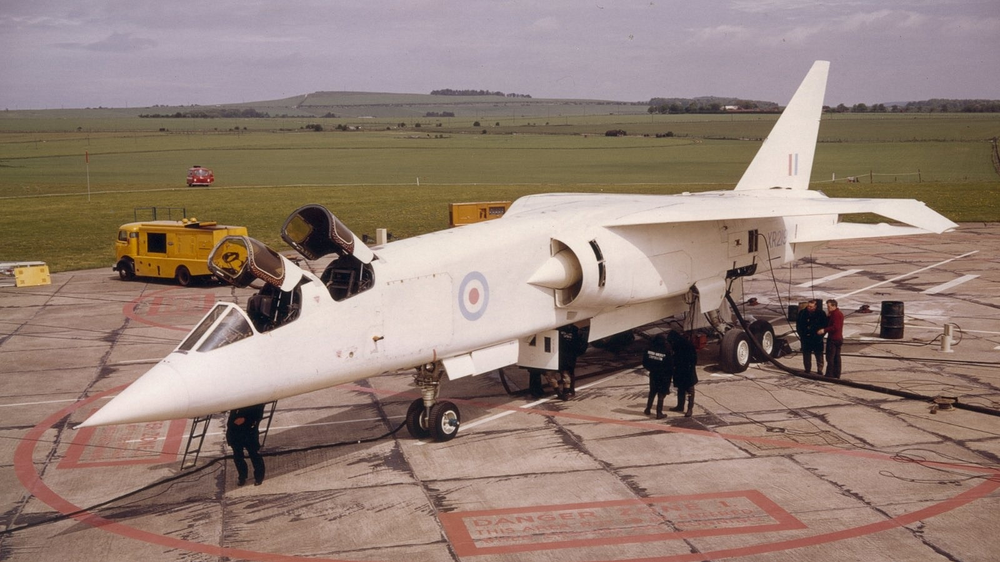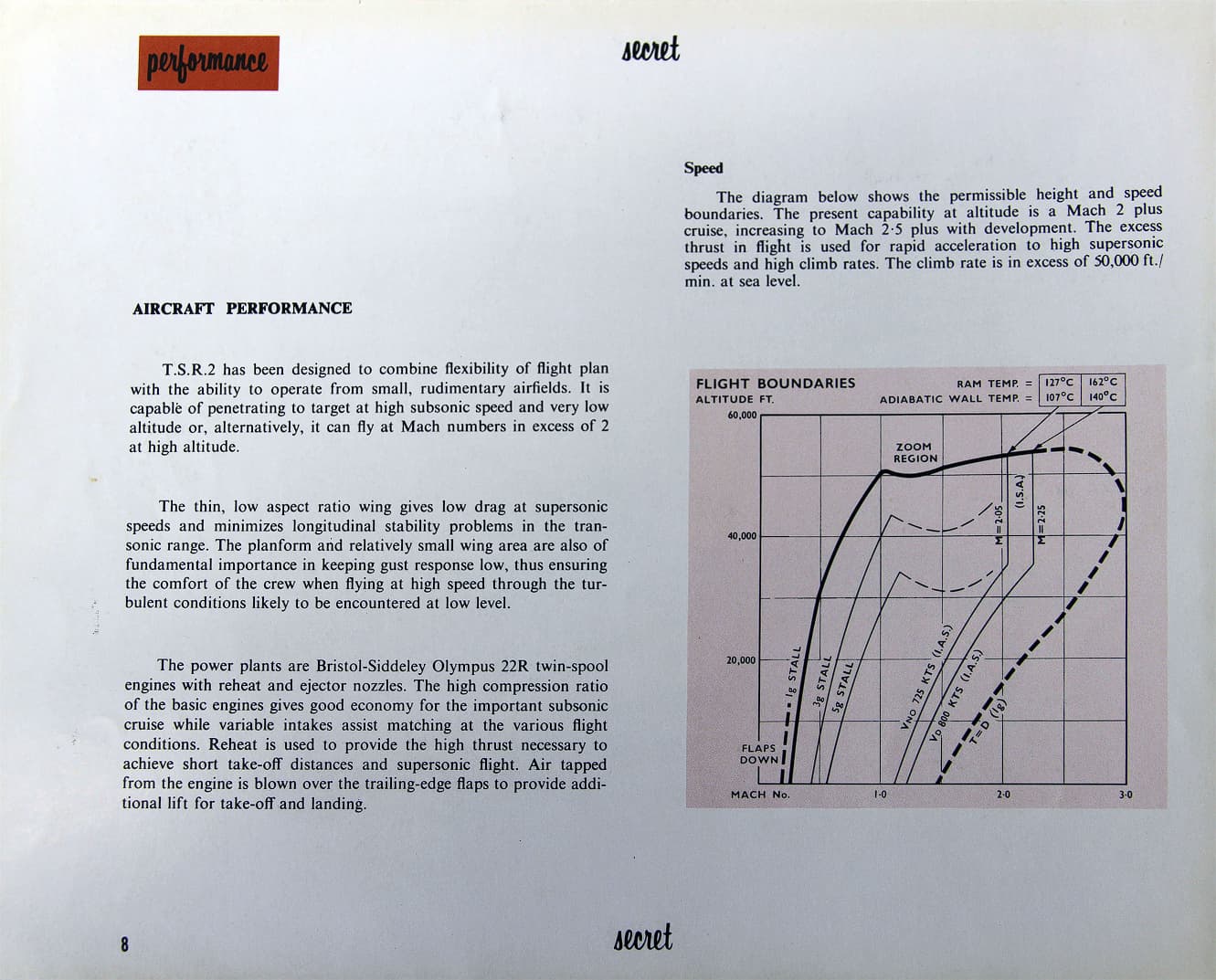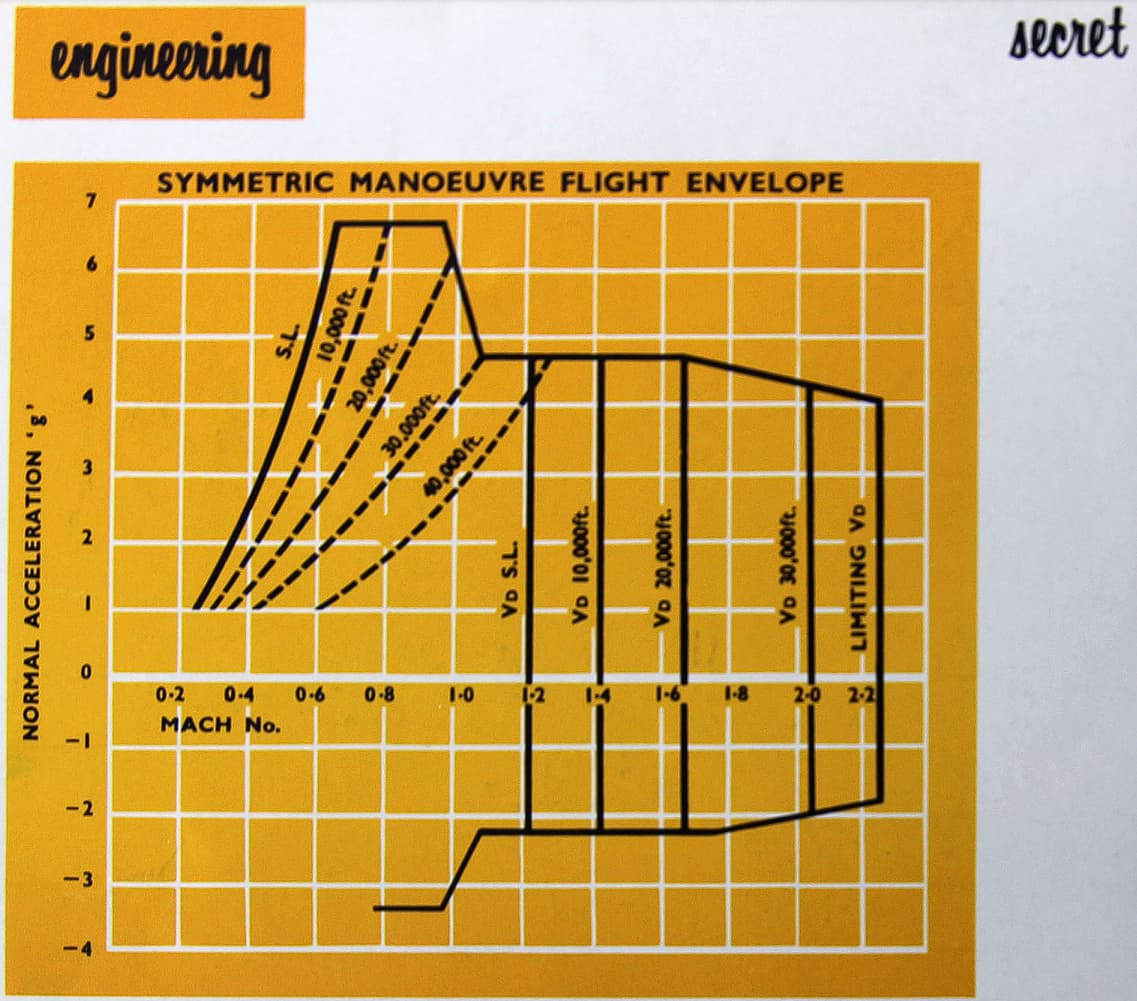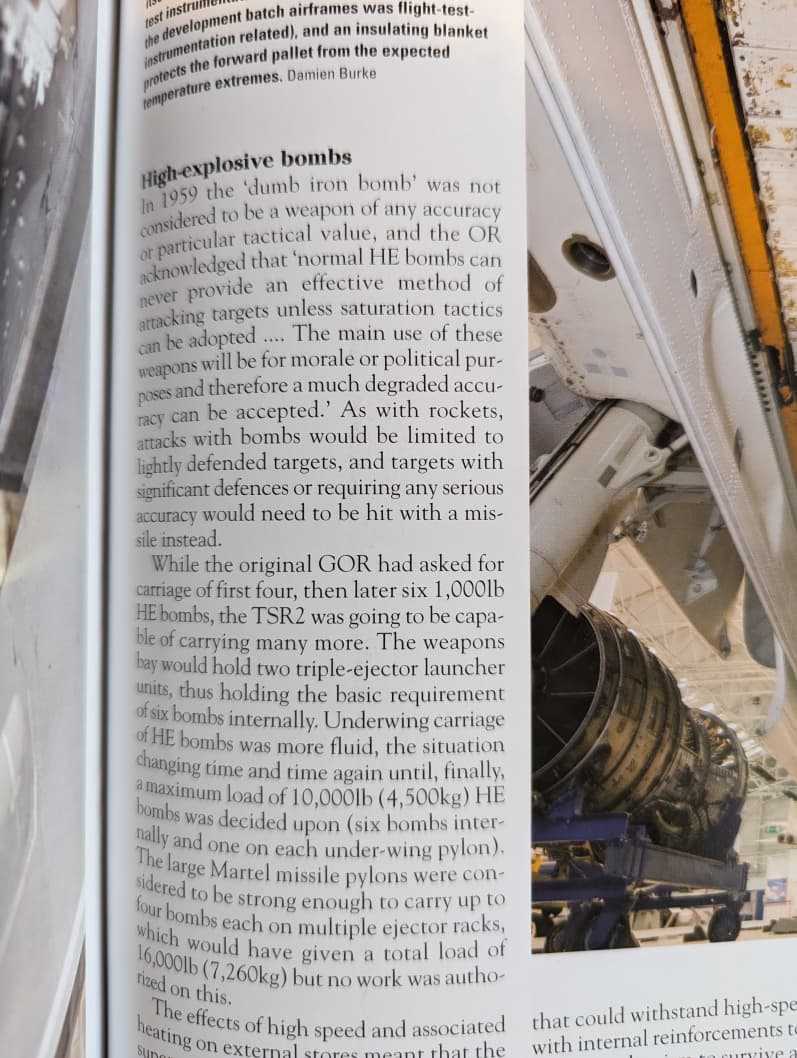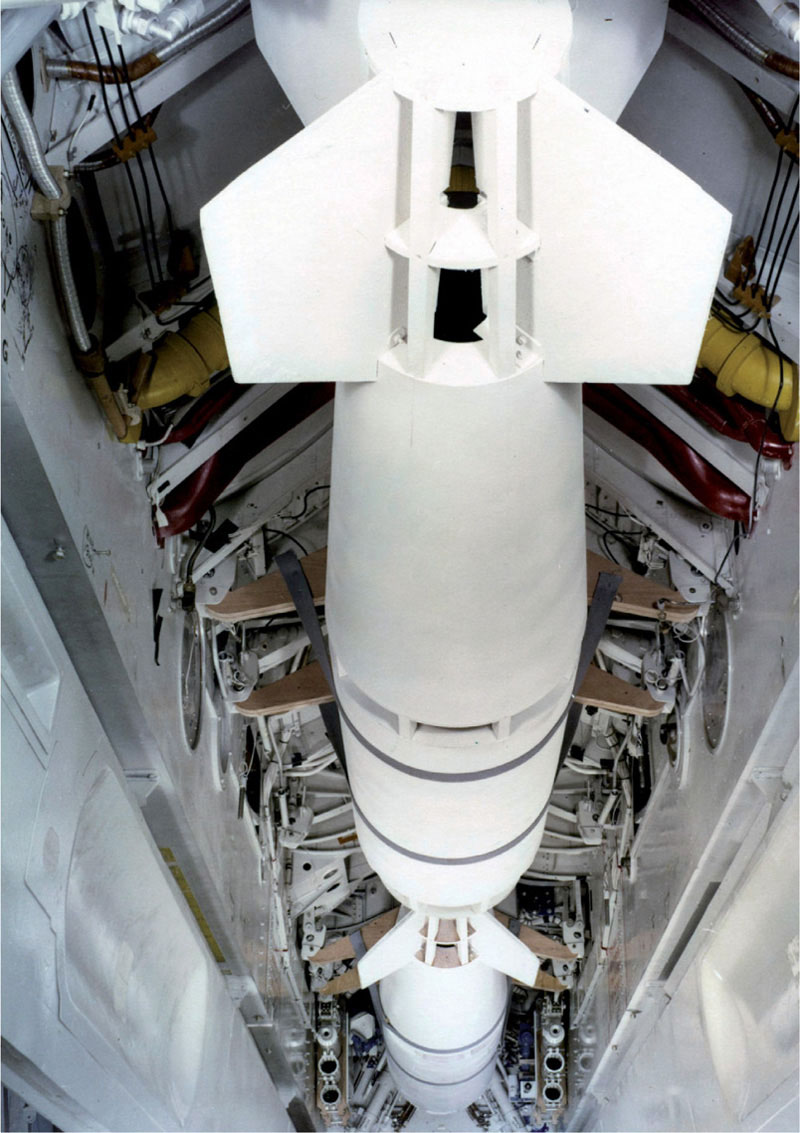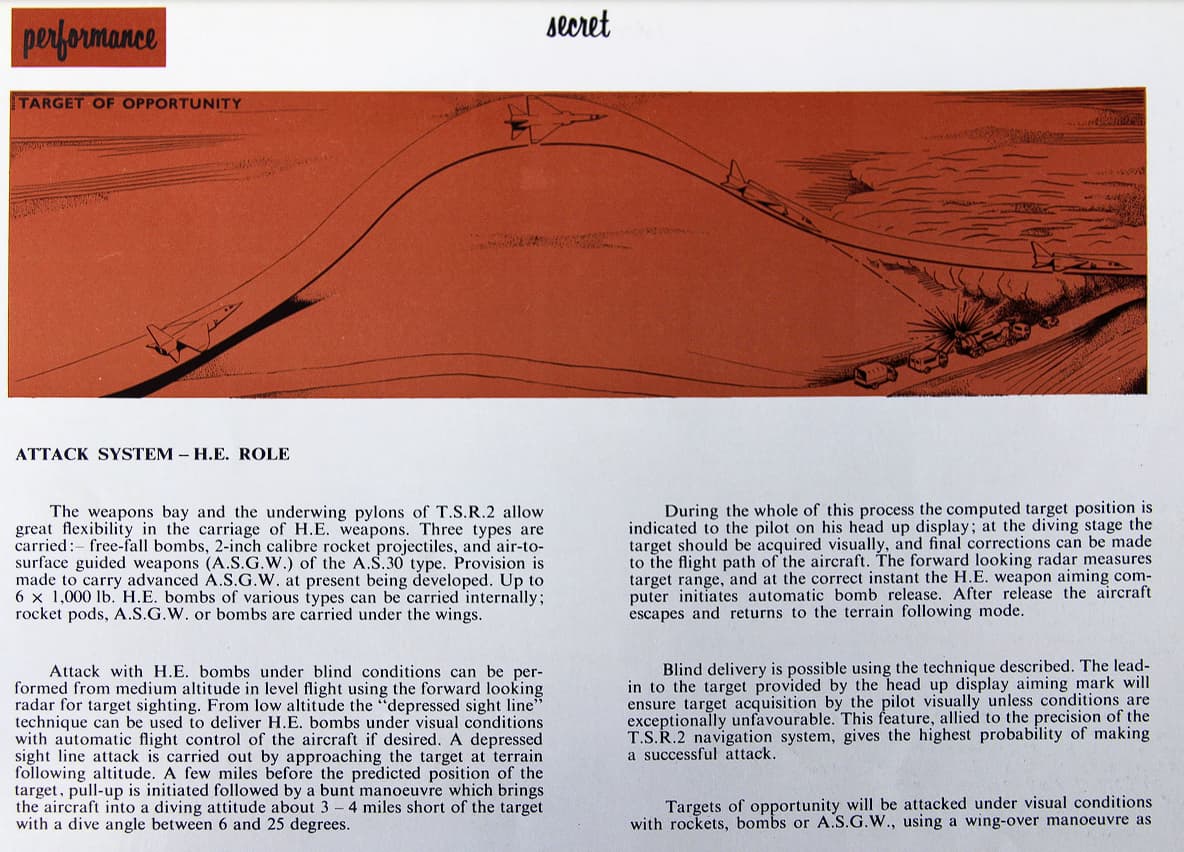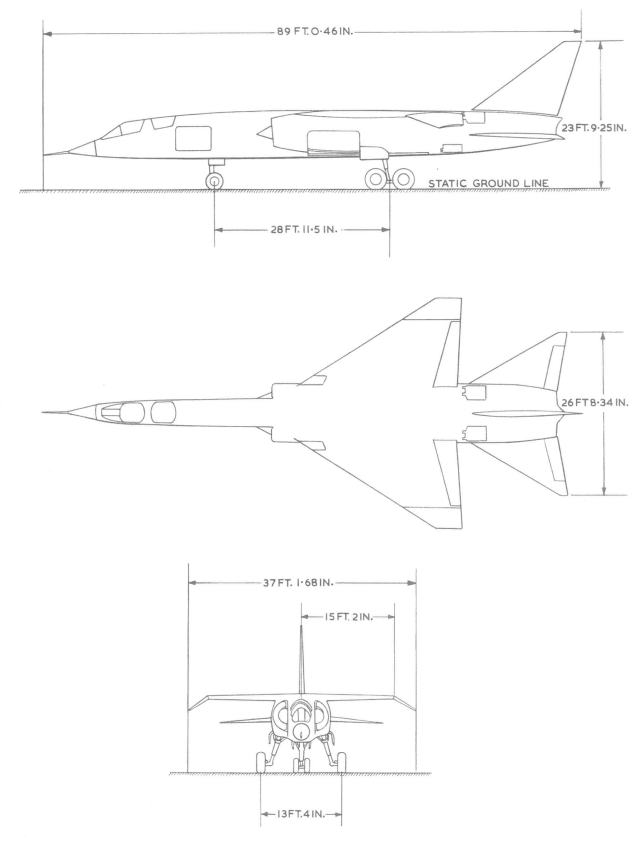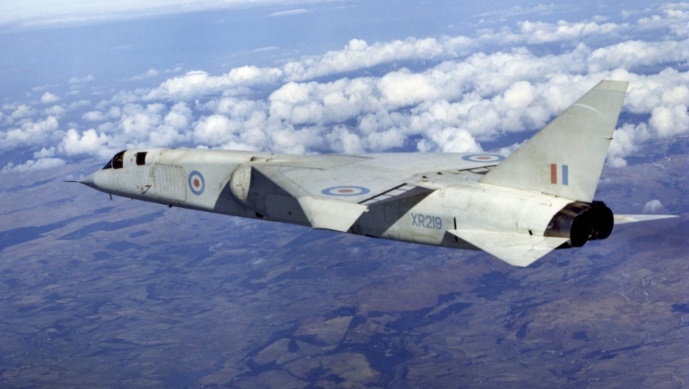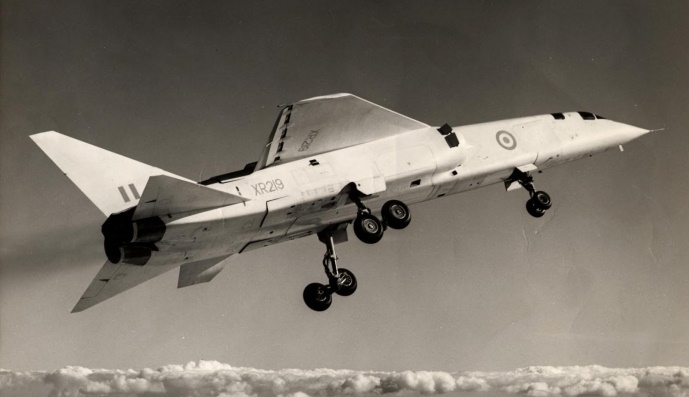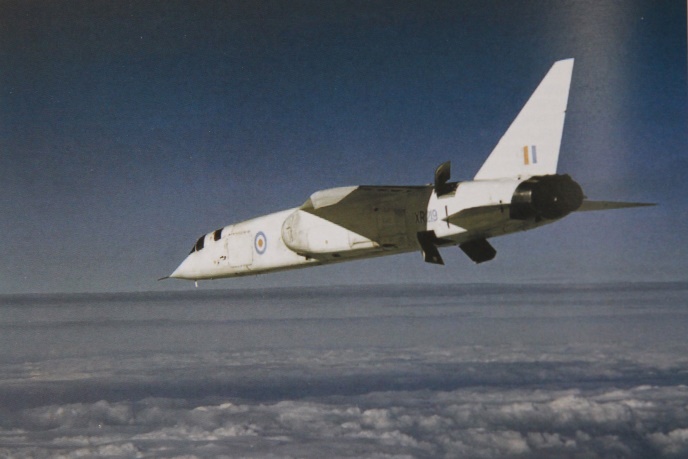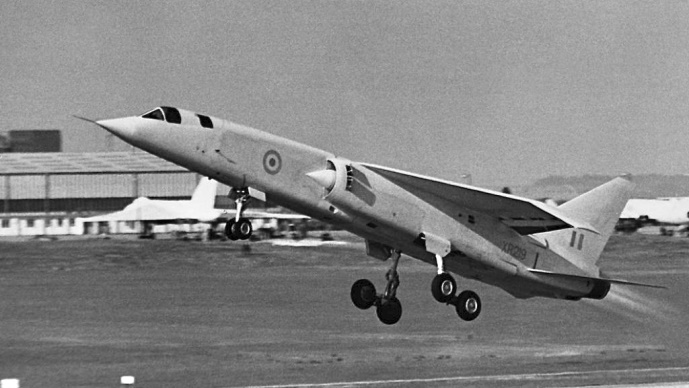- Yes - as a tech tree vehicle
- Yes - as an event / battle pass / squadron vehicle
- Yes - as a premium / pack vehicle
- No
Introduction
This is a joint suggestion by @AVROVULCANXH558 and @Flame2512
At the time of its development the British Aircraft Corporation TSR.2 promised to be one of the most advanced aircraft ever built. Its mission was twofold: to penetrate the iron curtain and deliver Britain’s tactical nuclear weapons should the Cold War ever turn hot, and to provide Britain with a high performance conventionally armed tactical strike and reconnaissance aircraft; suitable for worldwide operation, in order to support for troops in the far reaches of Britain’s Empire.
However it was not to be; the programme was cancelled in April 1965, on the same day the second prototype was due to make its maiden flight, in what remains one of the most controversial decisions in the history of British aviation.
At the time the programme was cancelled a single TSR.2 prototype was in use for flight trials and a second prototype was ready for flight; multiple other prototypes had also been essentially completed and were scheduled to begin flight trials in the weeks following the cancelation. Although the aircraft had not been fitted with live weaponry at this stage, the planned armament is well documented in both primary and secondary source material; there is also an extensive collection of photographs available showing the TSR.2 prototypes fitted with various mock weapons. In addition, nearly all of TSR.2’s avionics systems had either fitted to the prototype, or were undergoing rig testing prior to fitment. This puts the state of TSR.2 development in a very similar place to that of the Yak-141 (and various other prototype aircraft in the game): a prototype aircraft was flying (with multiple others completed), photographs exist of mock weapons fitted to the prototype, and all of the planned avionics systems exited and were either fitted or undergoing separate testing.
Despite never seeing service the TSR.2 is an iconic aircraft within the British aviation community, and is of profound historical significance due to the way in which it reshaped the British defence industry. In addition to the iconic nature of the aircraft, the TSR.2 has a unique combination of features, which would make it a worthy addition to the British tech tree.
History
@AVROVULCANXH558 has compiled a very detailed history of the TSR.2 programme.
Spoiler
The BAC TSR-2 can lay claim to being one of the most convoluted, controversial and debated aircraft programmes in aviation history. A project born in 1955 as a simple replacement for the Canberra bomber had turned into an extremely complex and innovative aircraft when it was put to death a decade later. Since then, there has been endless debate over the consequences of its cancellation, whether it would have been the defining aircraft of its decade, or whether its cancellation was justified.
To begin this story however, we must go back to World War 2. During this conflict, there were a large number of aircraft which stuck out due to their usefulness, but none were held in such high regard as the de Havilland Mosquito. This aircraft excelled in all the roles it was pushed to do, whether it was as a night fighter, photoreconnaissance or as a bomber, amongst many other roles. However a replacement was necessary by the end of the Conflict, as technology had caught up to, and exceeded it. The Mosquito would be replaced by a variety of aircraft, but in terms of versatility, its legacy was continued by the English Electric Canberra. The Canberra was Britain’s first jet bomber, but it would end up being modified numerous times and it would end up taking on a plethora of roles, with an even larger number of design studies remaining on the drawing board. However, in 1952, just a few years after entering service, the Air Staff saw that in light of experience gained from the Korean War against the MiG-15, it was becoming apparent that the Canberra would eventually be superseded by new Soviet fighter developments. Indeed, Air Vice-Marshal Geoffrey Tuttle, ACAS(OR), wrote in February of that year that “Frankly, I do not believe that we will get much operational value out of the Canberra from 1955 onwards … the aircraft is already out of date and I doubt its chances of survival in daylight against present MiG-15 opposition.” Similarly, Air Cdr. H.V. Satterly, DOR(A) wrote that he felt that the Canberra was “clearly incapable of development to meet the light bomber requirement.” A draft requirement was drawn up in March 1952 for a replacement, but at this point in time it was not given priority. At this point in time, it was viewed that a replacement for the Canberra at this point was to be a relatively simple, but fast aircraft, capable of taking on various roles such as interdiction, photoreconnaissance, target marking and night intruding. Wartime experience was still fresh in the minds of many in the Air Staff, and in effect, they saw this requirement as being a Mosquito of the 1950/60’s.
At around the same time as these studies were being drawn up, the Air Staff was looking at designing a high-speed, low altitude bomber to supplement the V-Bombers. At this time, the Air Staff came to the logical conclusion that once the V-Bombers and their American counterparts began to enter service, the Soviet Union would have begun to develop supersonic interceptors and surface-to-air missile systems that would make these high-flying aircraft incredibly vulnerable. Indeed, this was quite an incredible piece of foresight on behalf of the Air Staff, as this is exactly what would end up happening about a decade after this study was commenced. Specification B.126T was issued in May 1952, calling for a bomber which could fly at high-subsonic/transonic flight at low-level to attack targets deep in the enemy’s rear as a complement to the V-Force, or as the main bombing effort if losses for the latter were prohibitive. Companies were also asked to investigate the navigational, bombing and structural issues, as well as concerns about physiological issues on the crew. The requirement was quite open ended, in order to allow companies to produce their studies in an uninhibited manner. As a result, as wide range of configurations of aircraft from Avro, Handley Page, Short’s and Bristol. Whilst the full details of this project are outside the scope of this article, the project produced some highly important studies that would go on to influence a number of British bomber projects for the better part of two decades. For instance, the Institute of Aviation Medicine examined the causes and effects of airsickness at low-altitudes, and methods to counter it. Studies were also conducted in regards to aero-structures, as it became apparent that due to the buffeting and turbulence caused by bumpy air at low altitudes, that structures would need to be significantly beefed up in order to withstand them. There were also a number of flaws; the aircraft were effectively flying fuel tanks, as they were required to fly great distance at low altitudes. Another, even bigger issue was the fact that navigational technology of the time could not keep up with the aircraft; they flew too low and too fast. Despite B.126T’s cancellation, it provided much of the groundwork for the TSR.2 and later developments. It can be said that this project paved the way for the TSR.2, but it also laid out two major warnings for that project: that low-level penetration at high-speed would not be cheap and easy, and that significant technological development was necessary for the low-level bomber to work.
Gloster offered a version of the Thin Wing Javelin, which was dismissed on various grounds, mainly because it was cancelled in 1956 and ceased to exist as a project. Studies on fighter projects like the Fairey Delta III and SARO SR.177 were also conducted, but were found to be unsuitable. Other aircraft were also offered, including the P.1121, a modified version of the DH.110, the Supermarine Type 565 (a supersonic Scimitar development), and standard and modified variants of the Blackburn B.103 (the Buccaneer). Indeed, the latter would be a recurring character in the TSR.2 story, oftentimes much to the annoyance of the RAF. In fact, the RAF was trying its utmost to get the naval strike aircraft project cancelled in order to free up funds for themselves, but also because the Navy was promoting it as a strike capability to compete with the RAF. These proposals were all dismissed, as they either required extensive work, which would inevitably lead to cost overruns and delays, based off of previous experience, or were not deemed survivable enough.
GOR.339 was issued in 1957 calling for a self-contained, all-weather bomber, capable of airfield independent operations from damaged or dispersed strips of not more than 3000ft (914m). It was to be capable of the following roles:
- Delivery of tactical nuclear weapons from low altitudes by or night in all weather
- Photoreconnaissance at various altitudes
- All-weather electronic reconnaissance without compromising the nuclear delivery role
- Effective delivery of tactical nuclear weapons from medium altitudes under all conditions
- Effective delivery of conventional munitions under visual conditions.
The aircraft was required to fly 1000nm (1,852km) to and from its operating base without in-flight refuelling, with 400nm (740km) of that being flown at low-level. At this time, minimum penetration speed was Mach 0.95 at less than 1000ft (305m), but this was later upped to Mach 1.7 in 1958. Crew comfort was given priority, based off of previous studies showing crew discomfort at low levels and high speeds. Bomb delivery was to use a loft bombing method from low altitudes or a dive toss from medium altitudes. The aircraft was also supposed to enter service by 1964. Additionally, proposals would only be accepted from companies which were willing to work with others. This was due to the complexity of the program, but also as part of the plan to merge together Britain’s various design offices. Indeed, the program was so large and advanced that no one company could take on the project on its own.
GOR.339 was viewed by the industry more or less as the project of the century, and thus, most of the major design offices tendered their proposals, these being: Avro, Blackburn, Bristol, De Havilland, English Electric, Fairey, Hawker, Short Brothers and Vickers (Supermarine). Each design was interesting in and of itself, representing various means of achieving the same goal. Blackburn proposed a highly reworked version of the Buccaneer, and although it was the slowest, it was the safest option and could get into service the quickest. Bristol had a highly intriguing design, using a gothic wing and canard, with engine intakes mounted on top of the fuselage. De Havilland proposed a delta-winged aircraft, with a variable incidence wing. Shorts proposed a twin-engine VTOL strike aircraft with 28 lift jets. Fairey based their design off of research conducted by their Delta 2 aircraft, and therefore proposed a delta-canard design with engines slung under the wings. Hawker went all in, proposing a twin-seat version of the P.1121, a highly modified derivative of that aircraft called the P.1123, and two clean-sheet, designs, the P.1125 “Air Superiority Fighter” and the P.1129. Vickers (Supermarine) proposed the Type 571, an aircraft with a main focus on miniaturisation. Two versions were proposed, a small single-engine, and a larger, twin-engine variant. English Electric designed their P.17B design, a delta-winged aircraft of conventional layout with a dihedral on the wing. Avro’s design was similar, but possessed a conventional swept wing. Gloster and Handley Page also produced studies, but did not tender to this requirement. Choosing an aircraft from this long list of proposals required more than just a simple analysis of the various proposals; it was necessary to factor in a company’s ability to design, test, construct, prototype, and produce an aircraft. This all relied on a company’s experience in producing supersonic aircraft, flight test facilities, technical and management strength as well as specialist test facilities and experts in the fields of: aircraft handling, metal fatigue, thermodynamics, electronics and aircraft handling. No aircraft program in the history of the RAF up to that point had ever matched the level of complexity of this program.
The Hawker, Avro, EE and Vickers studies were the ones which were chosen to progress to the further procurement stages, as these were the companies with the most combined experience which was necessary for this project. Avro and Hawker were already a part of the Hawker Siddeley (HS) Group, and this connection would be leveraged further as the two companies began to go down the road of merger. Vickers and EE were merged together alongside some other companies to for British Aircraft Corporation (BAC). The companies were not the only things to merge however, their design proposals were also merged. At HS, there were worries over problems with cooperation between Avro. The latter saw that project as its natural area of interest, having had a long history of developing bombers, as well as having had the highly-advanced Type 720 and 730 get cancelled in 1957, the company’s future was not looking so certain. Thus, there was some conflict within HS as to which company was going to be given project lead. Indeed, there were worries that the lack of cooperation between the various parts of the group would jeopardise their entry. The P.1129 and Type 739 were both excellent designs, and both had been well received, although opinions from the RAE meant that the P.1129 had a slight edge. Both aircraft showed how different philosophies and interpretations of a requirement can lead to different solutions. The P.1129 gave priority to airfield performance and subsonic cruise at altitude, whereas the Type 739 placed emphasis on the low-altitude, high-speed portion of the flight. It was therefore decided to combine the two designs under the authority of Sir Sydney Camm and create a unified proposal. This design basically took the best of both designs and combined them together, and was called the “Supersonic Strike Aircraft”. Whilst it still lost out to the BAC Type 571 (the design that would become the TSR.2) it can be considered an excellent runner up to that design, as well as showing the difficulties and compromises present during the aircraft design phase.
OR.339 was rewritten as OR.343, effectively a requirement written around the EE/Vickers design. This new requirement was now much more precise, OR.339 having been broader in scope in order to test the waters. Now, OR.343 was backed up by further studies from various other sources, in order to verify what was known and add new research to the design. The requirement also further increased the complexity of the project, now requesting a minimum height of 200ft (61m) instead of 1000ft (305m), as well as Mach 2 at altitude, which required the addition of ECM. Additionally, a requirement for operations from damaged runways was also added. Development was expected to cost £62m, with the aircraft being released for service use with nuclear weapons in December 1965. The BAC Type 571 created out of the EE P.17A and the Vickers Type 571, with the wings and blown flaps, tails section and rear fuselage of the P.17A combined with the long fuselage of the Vickers design. With this in mind, the aircraft split in half from the wing box, with Vickers making everything in front of it, and EE making the wings, rear fuselage and tail. This thus satisfied the 50/50 workshare agreement between the two companies, and management for the program was made easier by the companies being integrated into each other under the BAC banner. The two companies complemented each other well, with Vickers having a long history of developing innovative aircraft, especially bombers, having developed the Valiant in the 1950’s. In the face of emerging electronic developments, the company had conducted a far-reaching study on avionics. EE was the only company in the UK that had conducted extensive research on speeds from Mach 2 and beyond having developed the Lightning and made studies for their P.10 bomber/research aircraft and was already laying the groundwork for even faster aircraft at this time (research was being done for beyond Mach 9). A brochure was produced in July 1959. That year, the Dutch and the Australians showed interest in the type. Due to the new requirements of OR.343, the aircraft grew 12.5% in weight. The delta wing of EE’s design was chosen as it gave better gust response and transonic handling. Blown flaps were also included in order to give better low-speed performance. The aircraft possessed all-moving fins and tail, part-span trailing-edge flaps and notched leading-edge on the wing. In 1959, the aircraft was still equipped with the square air intakes of the P.17A, these being changed out for rounded, variable half-cone intakes in 1960. In December 1959, the Ministry of Aviation requested approval from the Treasury for full development to proceed, but only limited approval was given as the Buccaneers was assessed once again, its “inadequacies” once again being a big point of contention. A cockpit mock-up was shown in January 1960, and in May, a study was requested for the use of the aircraft in a strategic role, including a stand-off capability using Blue Steel. The importance of the program was agreed upon in July, but Prime Minister Harold Macmillan reopened the project assessment phase the following month.
On September 11th, 1960, Chief Scientific Advisor to the Minister of Defence, Solly Zuckerman, began another comparison study between Buccaneer and TSR.2 project (the name of the program for the Type 571, which is used to refer to the aircraft much more than its actual designation.) He stated that there was no doubt that the TSR.2 possessed better performance than the Buccaneer, but he also made note that at that point in time the latter aircraft was also more or less invulnerable to current Soviet air defence systems, unless a supersonic fighter patrol was guarding the target. The only main advantages of the TSR.2 in this regard were its dash speed, its sideways-looking radar (SLAR) and its superiority in contour following abilities. The Air Staff argued that having a Mach 2 capable aircraft at altitude would allow for more mission profiles, but this advantage was rapidly being worn away by Soviet missile and radar technology, though they argued that this would be more useful against the various nations that Britain might have to fight across the globe as the decolonisation process continued. The Buccaneer could not go supersonic, but a radical redesign, the B.112, could get up to Mach 1.6, having been proposed to the Royal Navy as a long-range fighter. Zuckerman preferred to have both aircraft, but he also noted that if OR.343 was relaxed, a modified Buccaneer would be able to fit that requirement, and save the RAF a lot of money. Four days later, Minister of Defence Harold Watkinson argued for the TSR.2 to proceed, stating that it was impossible to compromise on the OR and that any compromise would result in an aircraft wholly unsound for service in the 1970’s. Therefore, an order for nine developmental aircraft was placed, with a first flight planned for March 1963.
However, problems immediately began to arise. The workshare agreement was a point of contention between the two companies. As mentioned, Vickers had no previous experience developing a Mach 2 capable aircraft, but it was effectively made project leader. This was ostensibly for production capacity reasons, as EE was busy with the Lightning and would not have had the spare capacity. They had to subcontract most of their work out for the Canberra program. But some within the company felt that this was a political decision, the Vickers plant at Weybridge was closer to London than the EE works at Warton. EE was also annoyed by the fact that Vickers was also undertaking multiple other projects which they saw as being distractionary from the TSR.2 program. There were also supply chain issues between the various contractors around the country. In January 1963, the Air Ministry noted its dissatisfaction to the head of Vickers, George Edwards, regarding the overall management of the program. Workshare issues were not the only issue however. Labour and material costs began to increase, but BAC also admitted to not making accurate estimates regarding predicted program costs, and analysis revealed that areas where BAC’s experience should have made development easier, were instead equally behind schedule as the parts which were breaking new ground. The issues regarding conventional airframe construction were likely brought about by the need to use expensive materials such as high-grade steel, titanium and aluminium-lithium alloy sheeting. Initially BAC and Bristol Siddeley (BSE) felt that the airframe and engines would not give any issues, and that it was the more exotic elements of the aircraft which would require more development, this mainly being in reference to the nav/attack system. In reality, the airframe took a lot longer to develop and manufacture than initially was planned, and the engines were also suffering reliability issues. This was all whilst the Air Staff were continuing to add new requirements, such as increasing payload capacity. There was also a political storm brewing in Parliament. There were worries about the increasing costs of the program, as well as questions as to the reversal of policy from the 1957 Defence White Paper, which cancelled the development of manned supersonic bombers. Now, the RAF was effectively developing just that. Members of the military establishment were also against the type. Solly Zuckerman now turned against the project after costs began to rise. The Chief of the Defence Staff, Fleet Admiral Lord Louis Mountbatten, also favoured the Buccaneer, partially because it was cheaper, but partially because it would increase the importance of the Royal Navy, which was proposing a carrier-strike force as an alternative to the manned bomber program (this would require new carriers, and of course, new escorts). The Labour Party under Harold Wilson was also quite hostile towards the program, but elements of the Conservative Party were also beginning to question the viability of the program.
In January 1963, Harold Macmillan asked for an update on the project and its costs from the Minister of Aviation, Julian Amery. It was found that overall program costs rose from £90m in 1959, to £137m in 1962 to $175m in 1963, with at least £3.5m in expenditure coming from requests from the Air Ministry to modify the aircraft after the program was approved. When neglecting wage increases and material costs, the net increase to the program was at least £65m. Amery thought that this was “very serious” and put it down to the following reasons (as quoted directly from BSP 2, quoting Amery):
- “The firms and the Ministry greatly underestimated the difficulty of the job and hence the time it would take. We were, of course, attempting something quite new and there was little or no past experience to guide us. In a project of this kind, delay in R&D involves a direct and steep increase in cost. It is the men’s time and the daily overheads of the firm that are expensive.”
- “Until very recently, management control of the airframe was in practice split between Vickers and English Electric.”
Due to the latter issue, the companies were finally brought under a single management team. Amery did not doubt the technical validity of the program but there remained some reservations within the upper echelons of the MoD. Watkinson is known to have written on a document “Minister: This is a terrible story. I suppose we are prisoners to our decisions. When will all this come out?”
When Alec Douglas-Home replaced Macmillan, he told his Minister of Defence, Peter Thorneycroft, that “I am rather troubled about this project. It seems to be turning out to be considerably more expensive than we thought and its military value is also being called into question. Ought we to have a new look at the whole venture and satisfy ourselves that it is still an integral element in our defence programme.” Thorneycroft replied by more or less saying that the Canberra would need replacement anyways, and that its survivability against even second-class opponents was dubious. It was also planned to supplement and eventually replace the V-Force in a conventional role, as they were to be phased out in the 1970’s.
In March 1963, the first flight was expected to be in January of 1964, but this was pushed back due to engine failures during ground testing. At this point, nine developmental, eleven pre-production and 138 production aircraft were planned. According to Tony Buttler, aircraft 1-9 were to remain as development aircraft, 10-14 were for A&AEE usage (likely weapons trials and certification); 15-20 were for the TSR.2 Development Squadron (No.237 OCU) at RAF Coningsby, with the rest to be dispatched to other squadrons. Nuclear strike was the main priority for the Air Staff, and the first 20 service aircraft were expected to be nuclear certified by January 1967. At this point, the Germans also showed interest in the aircraft as an F-104G replacement, but there were concerns in the Cabinet of the public backlash of selling a nuclear-capable aircraft to them. The program faced a huge setback when Australia decided to purchase the F-111 instead of TSR.2, which was effectively a political decision on behalf of the Australian Government, as the TSR.2 was expected to be ready ahead of that aircraft, and the RAAF had recommended purchasing the proven RA-5C Vigilante. It was already known that General Dynamics was facing issues with the F-111, and some members of the USAF command who were viewing both projects with a keen interest noted that Vickers was doing a better job at overcoming certain issues when compared to General Dynamics. Despite valiant efforts on part of Vickers, the costs continued to skyrocket. Various aspects of the aircraft were looked at for deletion, but it was found that cost savings would be minimal.
The first prototype, XR219, made its first flight on the 27th September, 1964. The aircraft performed very well, and it came as a relief to all the program managers that the test pilot, Roland Beamont, was pleased with its performance. This could have vindicated the project’s backers, but it came amid a large amount of controversy, with many in both Parliament and in the press criticising the project for its huge costs.
The following month, the Conservative Party was beaten by Labour in that year’s general election, and a whole review of the project was once again called. Harold Wilson, a major opponent of the program, was elected as Prime Minister, and his Minister of Defence, Denis Healey, was looking into alternatives to the program, as well as to a number of other projects, such as the P.1154 VTOL strike aircraft and the AW.681 transport. A fact finding missions was sent to the US to evaluate the F-111, F-4 and C-130, amongst others in order to gauge whether they fulfilled the requirements. At the turn of the year, rumours began spreading in the press that the TSR.2 was to be cancelled, and indeed, one of the aforementioned projects, the P.1154, was cancelled in February 1965. However, a decision about the TSR.2 had been deferred. Debate about the project had become very bitter. The technical success and superb flying qualities of the aircraft were countered by cost overruns and further delays. The R&D costs had risen to £272m and the run of 147 aircraft was raised to £410m. Whilst promising reports from Beamont were sent to the Aviation Minister, Roy Jenkins, alongside assurances from George Edwards about the development of aircraft, the whole project was reaching a critical point, and the end was in sight.
After two long meetings, it was decided to cancel the TSR.2 program on April 1st, 1965, with the decision being announced five days later during the budget speech. There were many debates over what was to be done, and Wilson proposed the following options:
- Delay a decision on TSR.2 even longer
- Cancel and take up the F-111
- Cancel and take up nothing
Many within the cabinet, including Roy Jenkins favoured cancellation without taking up the F-111, and Denis Healey fought a hard battle to replace it with that aircraft. The decision was neither made hastily, nor easily. There were still holdouts who wished to continue the project. The decision brought both praise and criticism, with many aghast at the implications of its cancellations, and others coming out in support of the decision. A proposal was put forward to keep the aircraft flying to support the Concorde program, and whilst no further flying was to take place, the single prototype was kept in operational condition. However, this proposal was shot down on financial grounds, thus marking the end of a long and tortuous project.
Replacements for TSR.2 were immediately looked at. The F-111 would eventually be procured, but the Mirage IV was also given some consideration. The UK would also team up with France to begin development of the Anglo-French Variable Geometry aircraft (AFVG), which would eventually form the basis of Tornado. The F-111 procurement would eventually be cancelled due to cost overruns, and the RAF would use the Buccaneer as a Canberra replacement until the arrival of the Tornado.
So this all begs the question: why did the TSR.2 fail? To begin with, the distinction between light, medium and heavy bomber had become quite blurred after the Second World War, which thus affected both design and doctrine. There was a clear distinction between something like a fighter-bomber such as the Hawker Typhoon when compared to an Avro Lancaster. But it was much harder to pin down a role from a doctrinal perspective for the gap in the middle. The RAF was a prolific user of light and medium bombers such as the Mosquito and Mitchell, but what defined them as such? Their usage, size, or bombload? These questions were never fully answered after the War, as these types ceased to be used in frontline RAF service once the Canberra was introduced. That aircraft was more or less simply a continuation of World War 2 legacy in jet form. Doctrine had also been forced to change due to technology. The nuclear bomb changed how wars were fought and the introduction of guided weapons changed both how aircraft were to attack targets, as well as how they were to be used. Hence, the distinction thus became between tactical and strategic, but again, how was this distinction to be defined? Was the Canberra replacement supposed to be a close air support platform to work in conjunction with the Army, an interdictor to destroy targets in the enemy’s rear, or simply a shorter-range counterpart to the V-Bomber fleet? The Canberra needed replacement, but how was its replacement supposed to turn out? To put it simply, there was no clear answer to any of these questions, and most of them remained completely unanswered during the TSR.2’s development. There was simply no clear goal from the start of the project. In 1963, a telegram from the Foreign Office noted that the TSR.2 was not, and was never intended to be, a basis of the British nuclear deterrent. But that’s effectively what it had become within a year of that being issued, something that it was never intended to do whatsoever. Additionally, since there was no clear path to follow during the development of the TSR.2, the program suffered from horrendous scope creep. The Air Staff constantly meddled with requirements, and as the project progressed, these became stricter and more technically complex (likely in the fallout of the shooting down of Francis Gary Powers in his U-2 in 1962), which added further complexity to the project as well as increasing costs further. For instance, the Mach 2 burst speed at altitude was likely not necessary, the idea being that the aircraft could use this in a “low-intensity” environment. But this idea was unfounded simply because the Soviets were willing to send their SAMs to other nations, as was proven not long after the TSR.2 was cancelled in the skies above both Vietnam and Egypt. Additionally, the whole premise of that was that Britain would have overseas posts to defend. But much of the Empire which had existed in 1957 had ceased to exist by 1965, and Britain was withdrawing from across the globe. Indeed, doubts had crept in from the very start as to whether the Air Staff was planning on a realistic basis. Back in April 1953, studies had already been conducted for a Canberra replacement, with particular reference to a speed of Mach 1.4. At the end of that month, P. Broad, DDOR1 noted: “We will not be able to afford a new light bomber if it is going to be larger than 60,000lb (27,216kg) gross weight when carrying a bomb load of not more than 10,000lb (4,536kg).” He also noted that any such aircraft would likely need to have a cruising speed between Mach 0.8 and 0.9 rather than anything above Mach 1. It can be said that these words were prophetic, as they described an aircraft much closer to the Buccaneer in both size and performance than anything like the TSR.2. Indeed, that aircraft would eventually fill the shoes of the TSR.2 throughout the 1960’s and 70’s, and it would turn out to be a rugged, reliable and completely survivable aircraft well into the 1980’s, as proven by various exercises against NATO allies, and testing against Soviet equipment such as the Strela-1 and the Kirov-class cruisers.
In summary, the TSR.2 was simultaneously the pinnacle of technological development for 1960’s aviation, as well as being a stunning procurement failure. Debates rage over this aircraft to this day, with many saying that it was a mistake for it to be cancelled. Still others state that the decision was justified, and some argue further still that it should have never been built in the first place. Personally, I would prefer to let you, the reader, decide for themselves, based off of the information I have presented.
Flight performance
The standout feature of the TSR.2 in game would be its excellent flight performance (see spoiler for details).
Spoiler
The TSR.2 was fitted with a pair of Bristol-Siddeley Olympus 22R engines each developing 30,610 lb of thrust at full afterburner. The total combined thrust output of 61,220 lb (minus installation losses) would give the TSR.2 more total thrust than any other aircraft in the game. The engines also feature water injection to further augment thrust for improved take-off performance.
There is an often told story about how on one test flight the pilot engaged the first stage afterburner on just one of TSR.2s engines (each afterburner had four stages) and was able to accelerate away from an English Electric Lightning chase plane which was following with both afterburners engaged. This story may seem a bit farfetched, but the TSR.2 brochure presents some truly impressive performance figures, which make it sound plausible.
The diagram on this page confirms that normal operating speed for the TSR.2 was 725 kts / Mach 2.05, while the airframe limit at this stage in development was 800 kts IAS / Mach 2.25 (limited by aircraft skin temperature). It also states that the ultimate plan was to clear the aircraft for cruise at speeds in excess of Mach 2.5 with further development. The most interesting line on the graph however is the 1g T=D line. This shows the speed at which the thrust produced the aircraft is equal to the drag, i.e. it is the maximum speed that the aircraft would be able to achieve in level flight, ignoring any restrictions due to airframe structural strength / temperature (it is essentially equivalent to SEP=0 on a Specific Excess Power graph). This line shows that the T=D speed for TSR.2 was just shy of Mach 1.5 at sea level and just shy of Mach 3.0 at altitude.
This means that the TSR.2’s engines produce far more thrust than is needed to accelerate the aircraft to its 800 kts limiting speed. The brochure acknowledges this stating “The excess thrust in flight is used for rapid acceleration to high supersonic speeds and high climb rates. The climb rate is in excess of 50,000 ft. / min. at sea level”.
In practice this means that the TSR.2 would have an 840 kts rip speed in game (800 kts * 1.05), and unlike most aircraft it would be able to easily reach this speed in level flight at all altitudes. Other aircraft in the game can reach speeds in excess of 800 kts at low level, but acceleration to these speeds tends to be quite slow as the aircraft is approaching its T=D point so has little excess thrust to accelerate with. By comparison because the TSR.2’s T=D point is so much higher it will be able to maintain rapid accelerate all the way up to the point where the wings break off.
It is also worth mentioning the 5g stall boundary shown on the graph. This shows that the TSR.2 was able to sustain a 5 g turn at altitudes over 30,000 ft. That is far better than comparable aircraft such as the Tornado.
These numbers are backed up by other primary source documents. A British Aircraft Corporation report on the TSR.2’s performance (below left) states that normal operating speeds listed are based on a “demonstrated clearance to 1.21M and 2.25M respectively”. The Royal Australian Air Force (RAAF) carried out an in depth evaluation of the TSR.2, in their report they confirm that the maximum design speed is 800 kts at sea level, and that “at this stage there is no reason to suspect that the aircraft will not be highly manoeuvrable”.
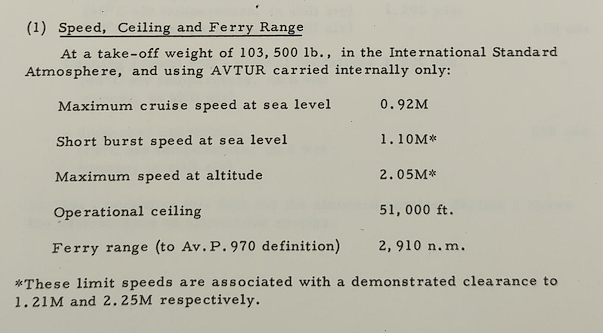
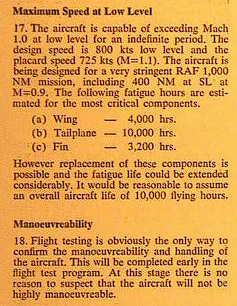
The TSR.2 brochure also confirms that the g limits were about +6.6g / -3.4g (giving +10g / -5g in game, once multiplied by 1.5):
Armament
As mentioned in the introduction the TSR.2 programme was cancelled before the aircraft could fly with live weapons, but the planned weapons are very well documented. The TSR.2 featured an internal weapons bay, along with four wing pylons. This gives rise to the following stores combinations (first image is from brochure, second is from TSR.2 Britain’s Lost Bomber):
Spoiler
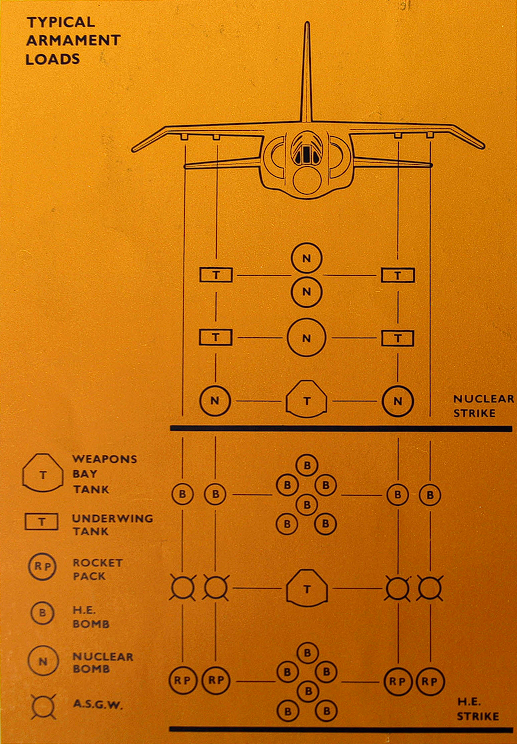
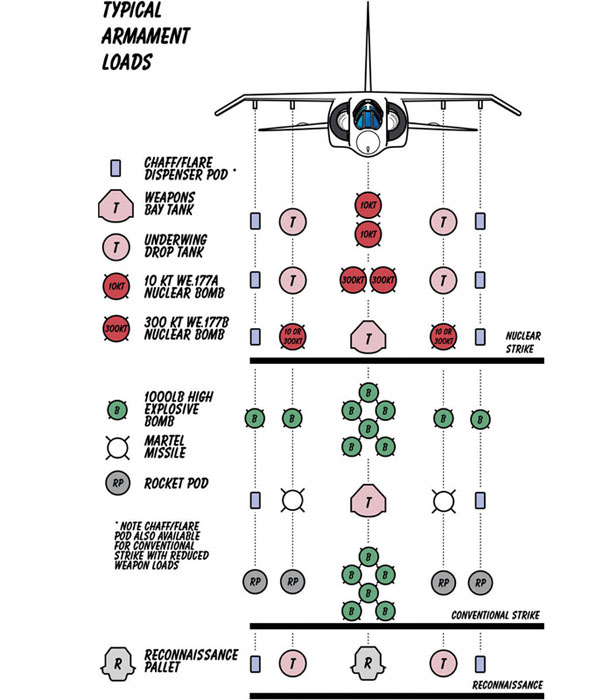
Conventional Bombs
Spoiler
As you would expect the TSR.2 could carry Britain’s standard 1,000 lb freefall or retarded bombs. The widely accepted maximum load is 10 x 1,000 lb bombs; six in the bomb bay and one on each of the four wing pylons; however there is evidence that a significantly larger load was possible (more on that below). The images below show mock-ups of standard 1,000 lb bombs (HE MC Mk.13 in game) in the bomb bay, and low drag 1,000 lb bombs (LD HE MC Mk.1 in game) on the wing pylons:
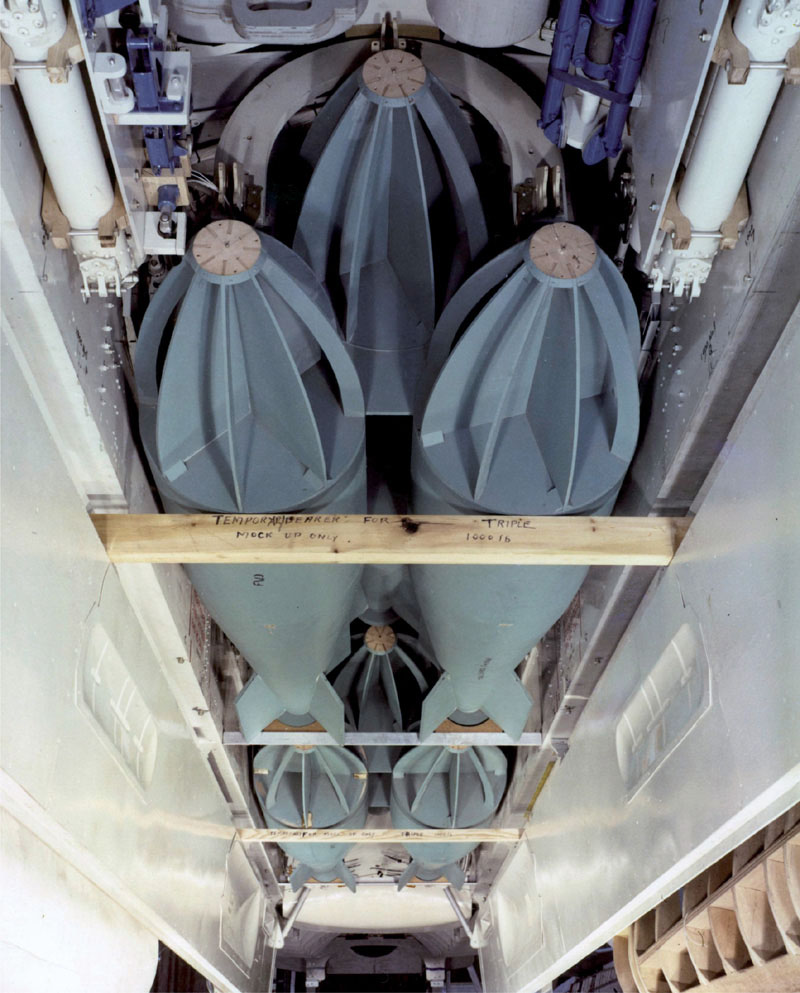
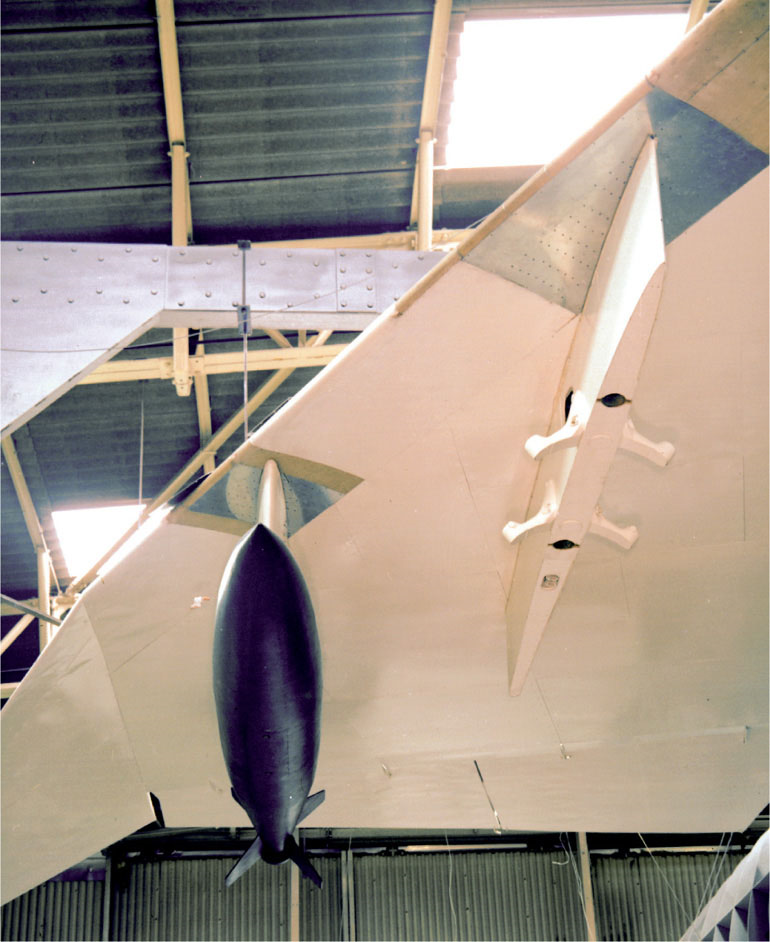
Potential for larger conventional bomb loads
Multiple sources support the idea that TSR.2 would have been capable of carrying more than one bomb per wing pylon had development progressed. In TSR.2 Britain’s lost bomber it is noted that the inner wing pylons were considered strong enough for up to 4 x 1,000 lb bombs on a multiple ejector rack, but that no work was carried out on this before the cancelation of the programme. In addition a MOD report comparing the TSR.2 to the MRCA (Tornado) states the maximum bomb load of TSR.2 would have been 16,000 lb (matching the theoretical value in the book).
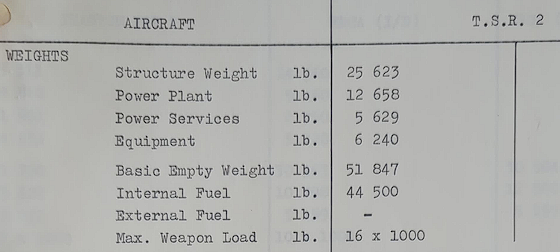
Finally the Australian evaluation of TSR.2 states that up to 8 x 1,000 lb bombs can be carried under the wings, in addition to 6 x, 1000 lb bombs in the bomb bay. This gives a maximum load of 14 x 1,000 lb bombs; this lower number may be a result of the Australians planning on carrying countermeasure pods on the outer wing pylons, or it may imply a loadout of three 1,000 lb bombs on each inner pylon rather than four.
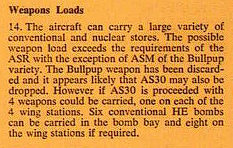
Air to surface missiles
Spoiler
TSR.2 was always intended to carry some form of air-to surface guided missiles on its four under wing pylons, as can be seen in the sales brochure loadout diagram (A.S.G.W means “air to surface guided weapon”). Originally this was intended to be the AGM-12B bullpup as shown in this page from a brochure reproduced in TSR2 Britain’s lost bomber:
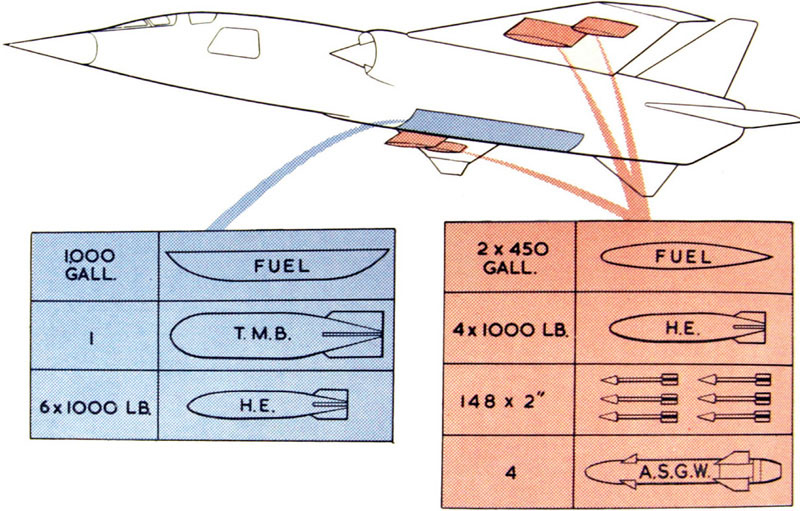
In 1962 the requirement was revised to be for TSR.2 to carry four AS.30 guided missiles, following an RAF decision that the Bullpup was not suitable for their needs. This option is where the majority of the engineering work on guided weapons went. You can see below an engineering drawing of the AS.30 installation, as well as an AS.30 loadout being tested in a wind tunnel.
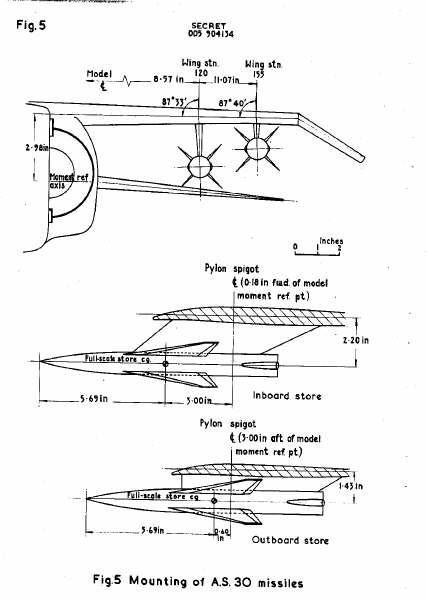
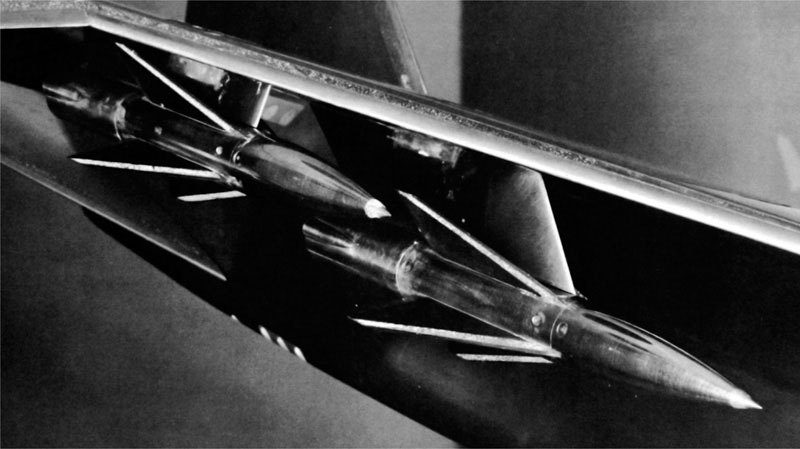
The Australian evaluation of TSR.2 also notes that AS.30 was the planned air-to-surface weapon:

According to TSR2 Britain’s lost bomber the requirement for AS.30 was also eventually dropped once the RAF realised the rocket motors on their existing stocks of AS.30 missiles (used on the Canberra B.15) would have expired by the time TSR.2 entered service. The requirement was once again amended for the TSR.2 to carry Martel missiles (both the TV and anti-radiation versions), but apparently little work was carried out on this before the programme was cancelled. The Aircraft Engineering journal also supports the idea of Martel on the TSR.2:
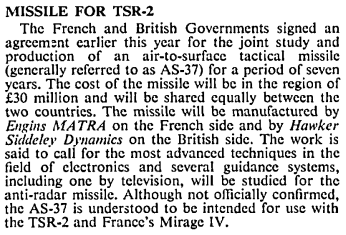
A final piece of evidence that TSR.2 was intended to use air-to surface missiles (and that work was carried out on the prototypes to enable this) is that the weapons control panel in the TSR.2 cockpit has a selection position for “GW” (Guided Weapons). In addition it has four indicator lights to show the status of missiles (the four lights at the top).
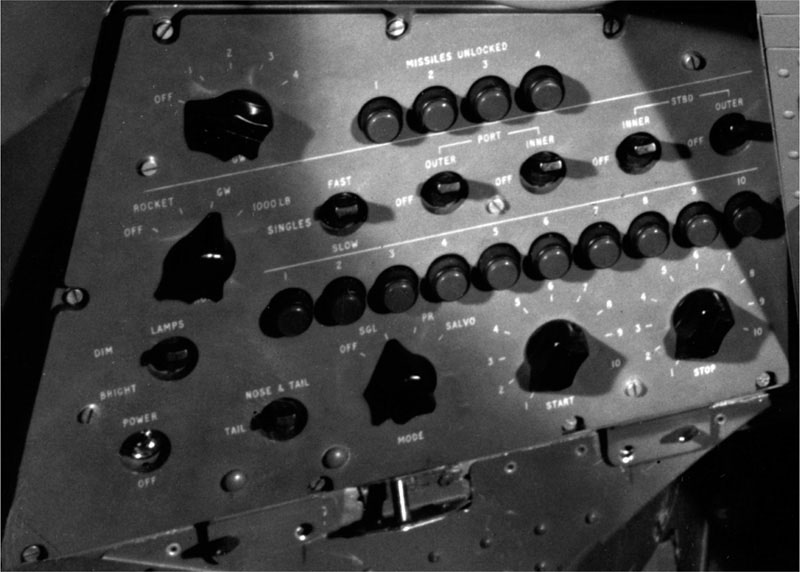
Rocket pods
Spoiler
As shown in both of the brochure diagrams included previously the TSR.2 was planned to carry 36 shot Launcher No.7 2” RP rocket pods on the under wing pylons. These are the pods that are currently in game on the Buccaneer, Sea harrier, etc. It’s worth noting that while these pods only have HE rockets in game they were also capable of firing AP rockets. Here the rocket pods can be seen being tested in a wind tunnel:
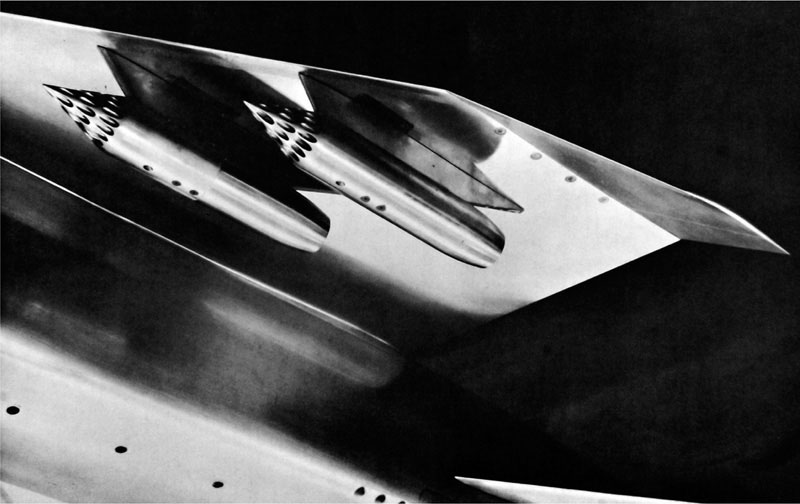
The TSR.2 Maintenance Manual also mentions rocket’s being used:

While the brochure confirms that the rockets used are the 2” RP (and that AS.30 was the missile planned at the time):

Nuclear weapons
Spoiler
While not entirely relevant to War Thunder (other than as a kill streak aircraft) the TSR.2 could carry either British W.E.177 or American B43 nuclear weapons. Two WE.177s could be carried in the bomb bay (either in tandem or side by side depending on the version of WE.177), along with one on each inner wing pylon (according to the loadout diagrams).
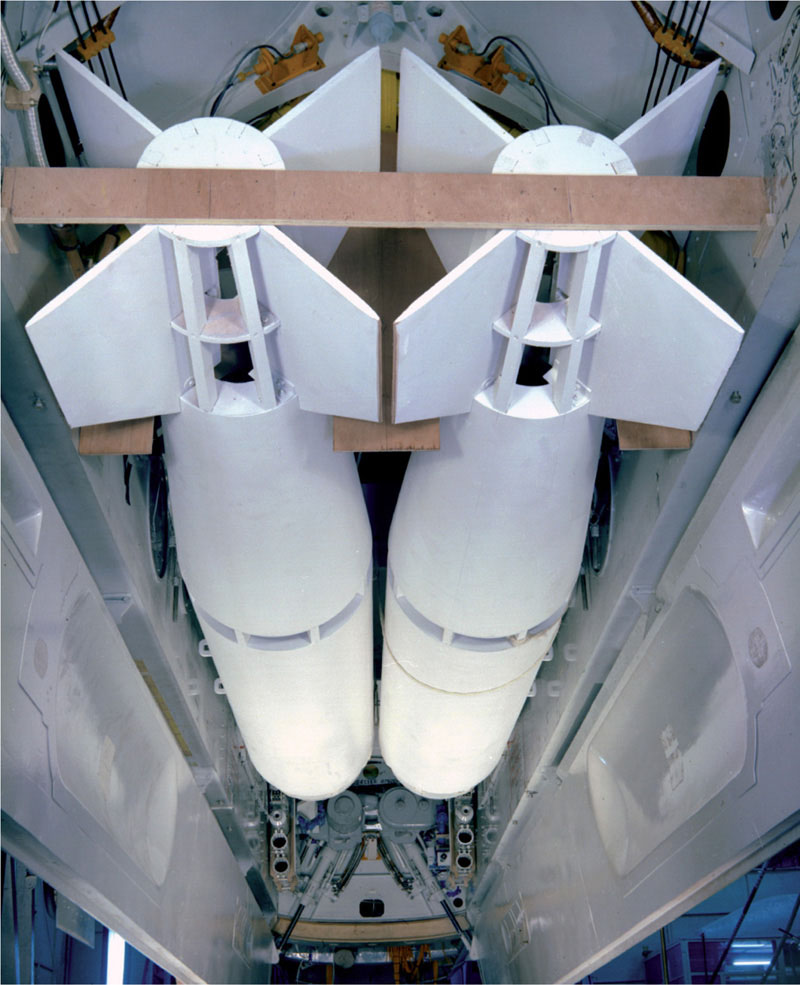
A single American B43 nuclear bomb could be carried in the bomb bay, with an additional one on each inner wing pylon:
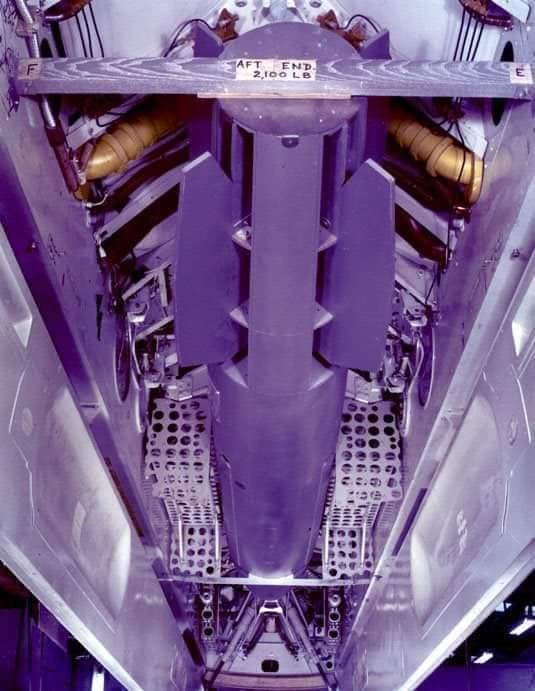
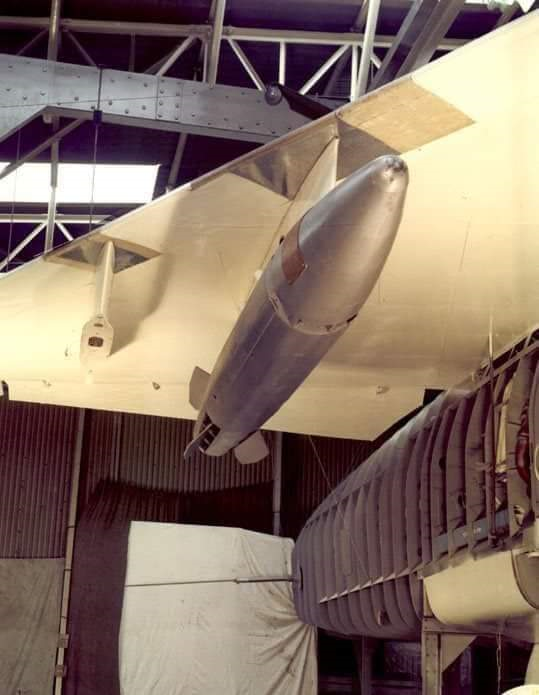
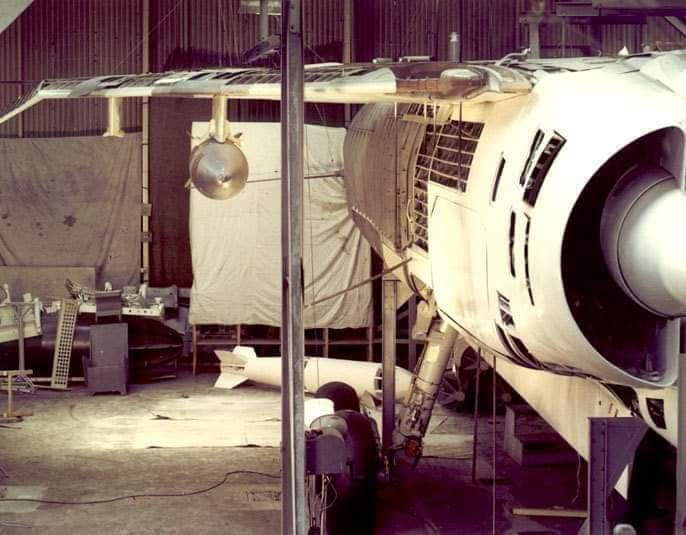
Survivability
TSR.2 included numbers features to help it survive its intended mission of penetrating deep into the Soviet Union.
Countermeasures dispensers
Spoiler
TSR.2 was to be equipped with a countermeasures pod that could be fitted under each outer wing pylon. The planned inclusion of these pods is confirmed by the Australian evaluation of TSR.2.
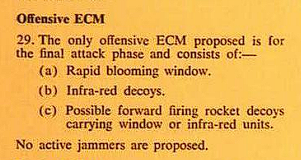
The technical details of these pods are described in TSR2 Britain’s Lost Bomber:
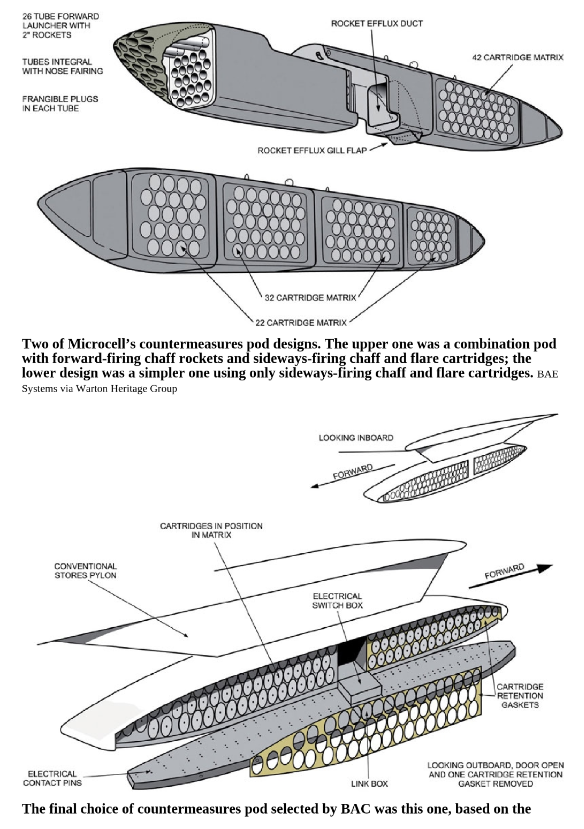
It should be noted that prototypes for these countermeasures pods appear to have been constructed, and indeed they are already present in game on the Buccaneer S.2. Notice the very close resemblance between the prototype flare dispenser on the Buccaneer and the design of the Microcell countermeasures pod from the book.
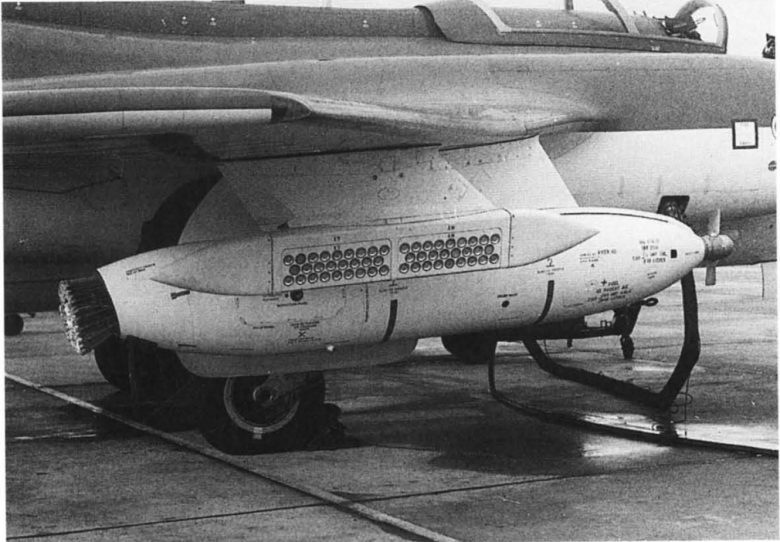
Radar Warning Receiver
Spoiler
The TSR.2 had an ARI.18203 Radar Warning Receiver. It is sometimes referred to as a Missile Warning System, but that appears to be due to its ability to detect CW and command guidance signals, rather than it having IR / active radar sensors to detect incoming missiles.
The RWR provided coverage from 2.5 – 18 GHz (legacy S, C, X & J band), as confirmed by the TSR.2 Brochure and Australian Assessment document.

Fire Suppression
Spoiler
As is standard for all British jet aircraft the TSR.2 was fitted with engine fire extinguishers. According to the TSR.2 Crew notes each engine was also contained within a fire-proof tunnel in order to stop an engine fire from spreading to the rest of the aircraft:

A somewhat unique feature of the TSR.2’s fire suppression system is that the two engine fire extinguishers are interconnected. As a result the pilot can choose to discharge one engine’s fire extinguisher bottle into the other engine. This means that if an engine catches fire and its own fire extinguisher fails to put the fire out (or if the engine catches fire a second time) then the pilot can redirect the other engine’s fire extinguisher into that engine.

Avionics
In order to meet the highly demoing requirements that the government set for the aircraft and its mission the TSR.2 was to be fitted with a suit of (for the time) highly advanced avionics.
HUD
Spoiler
The TSR.2 was one of the first aircraft in the world to feature a HUD. This HUD was projected directly on to the front windscreen of the aircraft. The operation and layout of the HUD is described in the TSR.2 Crew Notes and Maintenance Manual. In addition a video of the HUD being tested can be viewed here.
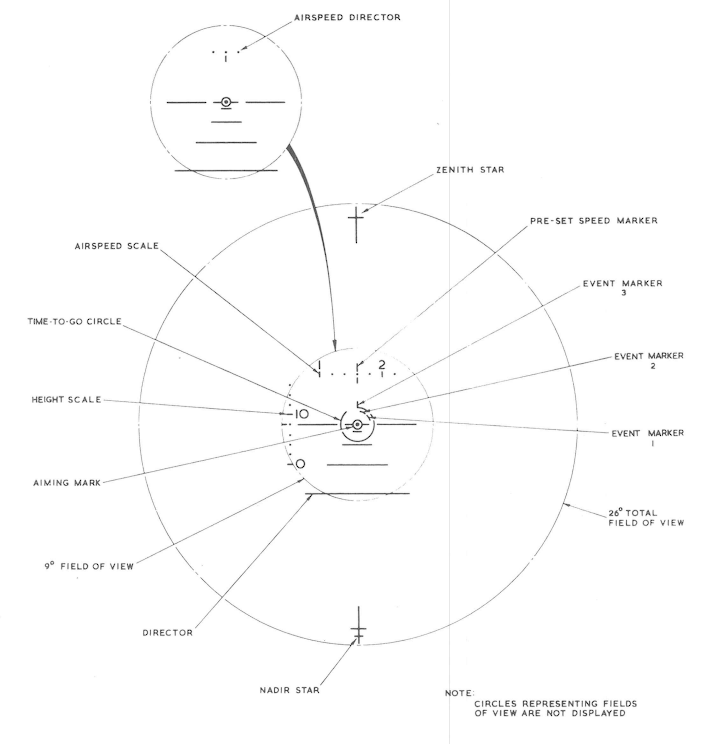
Ballistics Computer
Spoiler
The TSR.2 featured an advanced navigation and attack system which interfaced with the aircraft’s autopilot, allowing attacks to be carried out entirely automatically. Alternatively the pilot could fly the aircraft manually and use the attack system to provide CCRP and other weapon aiming functionality. This section of the crew notes describes how the AFCS (Automatic Flight Control System) can fly the aircraft through a delivery manoeuvre and atomically release weapons, before reverting control back to the pilot.

This page of the Brochure gives an overview of the weapon aiming functionality available. The maintenance manual also goes into extensive detail on how the navigation and attack system works.
Radar
Spoiler
The TSR.2 featured a Ferranti ARI.23129 forward looking radar. The radar had three main functions:
- Terrain following: This allowed for manual or automatic terrain following flight at altitudes as low as 30 m (100 ft.) above terrain.
- Ground mapping: This was a fairly standard ground mapping mode useful for navigation and identifying ground targets
- Radar ranging: This allowed the radar to determine the range to ground targets allowing for accurate CCRP against said targets
A 20 minute information film, produced by Ferranti, about the TSR.2’s radar can be accessed here. The film mainly focusses on the terrain following mode and confirms that accurate flight at altitudes as low as 100 ft. above terrain was consistently achieved during testing.
Moving Map
Spoiler
The TSR.2 was the first of many British aircraft (Harrier, Jaguar, Tornado, etc.) to feature a large moving map display in the cockpit (seen below in front of the flight stick). This functioned in much the same way that it did on the later aircraft, showing the pilot where they were located on a live moving map.
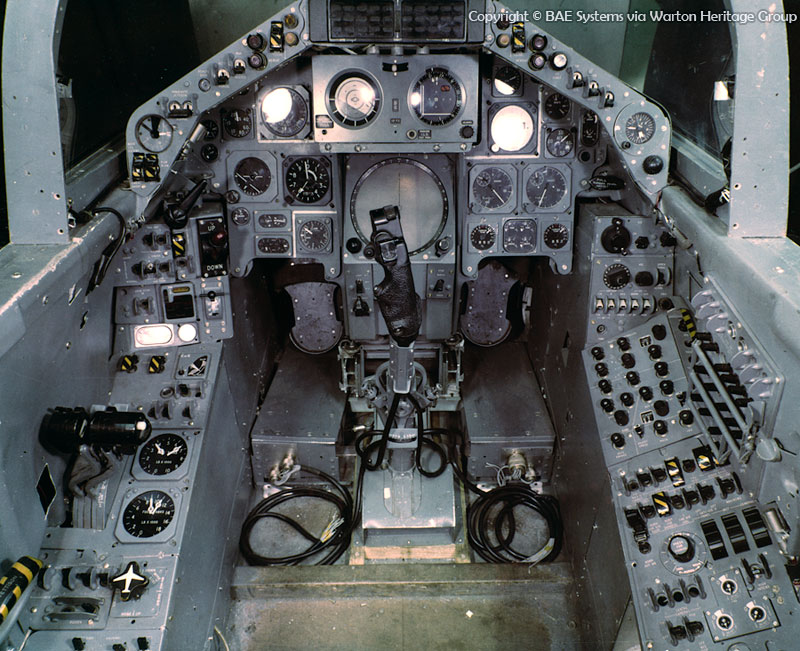
General Design / Specifications
The TSR.2 was a large aircraft with a two man crew (pilot and navigator) seated in separate tandem cockpits. There was avionics bay behind the cockpit, with the rest of the fuselage taken up by the fuel tanks, weapon bay, and engines. The TSR.2 featured a number of distinctive and novel design choices; for example the shoulder mounted delta wing which features no ailerons; instead the entire trailing edge is taken up by blown flaps to improve take-off / landing performance while roll control is provided by the two all-moving horizontal stabilisers. The large vertical tail fin also has no rudder, instead the entire fin pivots to provide yaw control.
Specifications
Spoiler
Dimensions
- Length: 89 ft
- Height: 24 ft
- Wingspan: 37 ft
- Wing area: 700 sq. ft
Flight performance
- Engines: 2 x Bristol-Siddeley Clymings 22R afterburning turbojet engines
- Static thrust (dry): 19,600 lb each
- Static thrust (wet): 30,610 lb each
- Max design speed (i.e. rip speed): 800 kts at sea level (just over Mach 1.2) / Mach 2.25 at altitude (with a plan to increase that to Mach 2.5 later in development)
- Maximum speed in level flight: Able to exceed design speed at all altitudes.
- Rate of climb: In excess of 50,000 ft per minute at sea level
- Maximum G Limits: +6.6 g / -3.3g
Weaponry
- 10 x 1000 lb bombs (six in the bomb bay + one on each wing pylon) - typical
- Up to 16,000 lb bombs potentially possible
- 4 x WE.177 nuclear bomb (two in bomb bay + one on each inner wing pylon)
- 4 x Launcher No.7 36-shot 2" rocket launcher (one on each wing pylon)
- 2 x AS.37 Martel anti-radiation missile (one on each inner wing pylon)
- 2 x AJ 168 Martel TV guided missile (one on each inner wing pylon + datalink pod in bomb bay)
- 2 x 108 shot 2.25" countermeasures pod (one on each outer wing pylon)
Images / diagrams
Sources
Despite stories about how large amounts of TSR.2 technical documentation was destroyed following the programme’s cancelation a significant amount of primary source material survives in various archives (the RAF Museum and National Archives among others). The following sources have been used in drafting this suggestion:
Spoiler
- Official BAC Publications
- T.S.R.2 Crew Notes
- T.S.R.2 Maintenance Manual
- TSR.2 Weapons System – British Aircraft Corporation Brochure
- TSR.2 Performance Data – British Aircraft Corporation Report
- Archival Documentation
- AVIA 65/2331 Comparison of Tactical Strike and Reconnaissance 2 (TSR2) and Multi-Role Combat Aircraft (MRCA) general performance
- AVIA 13/1336 TSR2 Weapons
- AVIA 65/1803 TSR2 Overall Aspects
- Report of the Evaluation Team on a strike/ reconnaissance aircraft for the RAAF
- Books / Journals
- “British aircraft corporation: TSR‐2”, Aircraft Engineering and Aerospace Technology, Vol. 36 No. 11, pp. 338-361
- “TSR2 Britain’s Lost Bomber” by Damien Burke
- “British Secret Projects 2: Jet Bombers since 1949” by Tony Buttler
- “Britain’s Cold War Bombers” by Tim McLelland
- “Bombers” by Francis Crosby
- “Vulcan’s Hammer: V-Force Projects and Weapons Since 1945” by Chris Gibson
- RAF Historical Society - TSR2 with Hindsight
- Websites
- TSR-2 HUD Symbology, Hardware & Testing
- Ferranti Strike and Terrain Following Radar
- Secret Projects - BAC TSR2
- AirVectors - BAC TSR.2
- BAE Systems Heritage - BAC TSR-2
- Imperial War Museum - The brilliant British bomber that never was: BAC TSR-2
- Thunder & Lightnings - British Aircraft Corporation TSR2 - History
